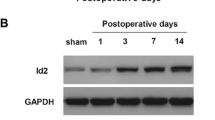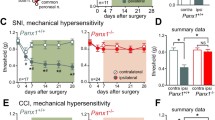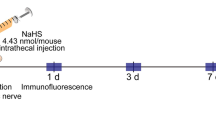Abstract
Neuropathic pain is a refractory disease with limited treatment options due to its complex mechanisms. Whereas erythropoietin-producing hepatocyte A1 (EphA1) mediates the production of inflammatory factors that are important in the progression of neurological diseases, its role and molecular mechanisms in neuropathic pain remain unclear. In the present study, we established a mouse model of chronic constriction injury (CCI). EphA1 expression was observed to be progressively upregulated at the mRNA and protein levels with the progression of the disease. Subsequently, knockdown of EphA1 expression levels using adenovirus short hairpin RNA (AAV-shEphA1) revealed an increase in mechanical stimulation withdrawal threshold (PWT) and withdrawal latency (PWL) when EphA1 expression was decreased, accompanied by improved dorsal root ganglion injury, increased leukocytosis, decreased microglia, and decreased levels of pro-inflammatory factors. For the underlying mechanism, it was found that EphA1 regulates the activity of the RhoA/ROCK2 pathway by modulating the level of CXCR4. Inhibition of CXCR4 and RhoA/ROCK2 could effectively alleviate the promoting effect of EphA1 upregulation on neuropathic pain. In conclusion, our study suggests that depletion of EphA1 ameliorates neuropathic pain by modulating the CXCR4/RhoA/ROCK2 signaling pathway, and targeting EphA1 may be a potential clinical treatment for neuropathic pain.







Similar content being viewed by others
Data availability
The authors declare that all data supporting the findings of this study are available within the paper, and any raw data can be obtained from the corresponding author upon request.
References
Huang YK, Lu YG, Zhao X, Zhang JB, Zhang FM, Chen Y, et al. Cytokine activin C ameliorates chronic neuropathic pain in peripheral nerve injury rodents by modulating the TRPV1 channel. Br J Pharmacol. 2020;177(24):5642–57. https://doi.org/10.1111/bph.15284.
Gao WS, Qu YJ, Huai J, Wei H, Zhang Y, Yue SW. DOK3 is involved in microglial cell activation in neuropathic pain by interacting with GPR84. Aging (Albany NY). 2020;13(1):389–410. https://doi.org/10.18632/aging.202144.
Walters ET. Neuroinflammatory contributions to pain after SCI: roles for central glial mechanisms and nociceptor-mediated host defense. Exp Neurol. 2014;258:48–61. https://doi.org/10.1016/j.expneurol.2014.02.001.
Mu Y, Mei Y, Chen Y, Li Y, Zhu D, Cui J, et al. Perisciatic nerve dexmedetomidine alleviates spinal oxidative stress and improves peripheral mitochondrial dynamic equilibrium in a neuropathic pain mouse model in an AMPK-dependent manner. Dis Markers. 2022;2022:6889676. https://doi.org/10.1155/2022/6889676.
Zhang F, Wang H, Zhou Y, Yu H, Zhang M, Du X, et al. Inhibition of phosphodiesterase-4 in the spinal dorsal horn ameliorates neuropathic pain via cAMP-cytokine-Cx43 signaling in mice. CNS Neurosci Ther. 2022;28(5):749–60. https://doi.org/10.1111/cns.13807.
Ma J, Wang Z, Chen S, Sun W, Gu Q, Li D, et al. EphA1 activation induces neuropathological changes in a mouse model of Parkinson’s disease through the CXCL12/CXCR4 signaling pathway. Mol Neurobiol. 2021;58(3):913–25. https://doi.org/10.1007/s12035-020-02122-x.
Ieguchi K, Maru Y. Roles of EphA1/A2 and ephrin-A1 in cancer. Cancer Sci. 2019;110(3):841–8.
Lisabeth EM, Falivelli G, Pasquale EB. Eph receptor signaling and ephrins. Cold Spring Harb Perspect Biol. 2013;5(9): a009159.
de Lemos L, Dias A, Nóvoa A, Mallo M. Epha1 is a cell-surface marker for the neuromesodermal competent population. Development. 2022;149(6): dev198812.
Wang H-F, Tan L, Hao X-K, Jiang T, Tan M-S, Liu Y, et al. Effect of EPHA1 genetic variation on cerebrospinal fluid and neuroimaging biomarkers in healthy, mild cognitive impairment and Alzheimer’s disease cohorts. J Alzheimers Dis. 2015;44(1):115–23.
Hang L, Shao D, Chen Z, Sun W. Spinal RhoA/Rho kinase signalling pathway may participate in the development of bone cancer pain. Basic Clin Pharmacol Toxicol. 2013;113(2):87–91. https://doi.org/10.1111/bcpt.12069.
Tatsumi E, Yamanaka H, Kobayashi K, Yagi H, Sakagami M, Noguchi K. RhoA/ROCK pathway mediates p38 MAPK activation and morphological changes downstream of P2Y12/13 receptors in spinal microglia in neuropathic pain. Glia. 2015;63(2):216–28. https://doi.org/10.1002/glia.22745.
Xu H, Peng C, Chen X, Yao Y, Chen L, Yin Q, et al. Chemokine receptor CXCR4 activates the RhoA/ROCK2 pathway in spinal neurons that induces bone cancer pain. Mol Pain. 2020;16:1744806920919568. https://doi.org/10.1177/1744806920919568.
Choi D, Stark D, Raphael R, Wen J, Su J, Zhou X, et al. SDF-1α stiffens myeloma bone marrow mesenchymal stromal cells through the activation of RhoA-ROCK-Myosin II. Int J Cancer. 2015;136(5):E219–29. https://doi.org/10.1002/ijc.29145.
Dong J, Xia R, Zhang Z, Xu C. lncRNA MEG3 aggravated neuropathic pain and astrocyte overaction through mediating miR-130a-5p/CXCL12/CXCR4 axis. Aging. 2021;13(19):23004–19. https://doi.org/10.18632/aging.203592.
Wang L, Yin C, Liu T, Abdul M, Zhou Y, Cao J-L, et al. Pellino1 regulates neuropathic pain as well as microglial activation through the regulation of MAPK/NF-κB signaling in the spinal cord. J Neuroinflammation. 2020;17(1):1–16.
He L, Han G, Wu S, Du S, Zhang Y, Liu W, et al. Toll-like receptor 7 contributes to neuropathic pain by activating NF-κB in primary sensory neurons. Brain Behav Immun. 2020;87:840–51.
Shao S, Xu CB, Chen CJ, Shi GN, Guo QL, Zhou Y, et al. Divanillyl sulfone suppresses NLRP3 inflammasome activation via inducing mitophagy to ameliorate chronic neuropathic pain in mice. J Neuroinflammation. 2021;18(1):142. https://doi.org/10.1186/s12974-021-02178-z.
Zhang LQ, Gao SJ, Sun J, Li DY, Wu JY, Song FH, et al. DKK3 ameliorates neuropathic pain via inhibiting ASK-1/JNK/p-38-mediated microglia polarization and neuroinflammation. J Neuroinflammation. 2022;19(1):129. https://doi.org/10.1186/s12974-022-02495-x.
Rodríguez-García R, Volkov V, Chen C, Katrukha E, Olieric N, Aher A, et al. Mechanisms of motor-independent membrane remodeling driven by dynamic microtubules. Current biology: CB. 2020;30(6):972-87.e12. https://doi.org/10.1016/j.cub.2020.01.036.
Safieh-Garabedian B, Nomikos M, Saadé N. Targeting inflammatory components in neuropathic pain: the analgesic effect of thymulin related peptide. Neurosci Lett. 2019;702:61–5.
Yin D, Chen Y, Lu R, Fan B, Zhu S, Xu X, et al. Translocation associated membrane protein 1 contributes to chronic constriction injury-induced neuropathic pain in the dorsal root ganglion and spinal cord in rats. J Mol Neurosci. 2018;66(4):535–46.
Sun C, Tao X, Wan C, Zhang X, Zhao M, Xu M, et al. Spinal cord stimulation alleviates neuropathic pain by attenuating microglial activation via reducing colony-stimulating factor 1 levels in the spinal cord in a rat model of chronic constriction injury. Anesth Analg. 2022;135(1):178–90. https://doi.org/10.1213/ane.0000000000006016.
Wang Y, Yu H, Shan Y, Tao C, Wu F, Yu Z, et al. EphA1 activation promotes the homing of endothelial progenitor cells to hepatocellular carcinoma for tumor neovascularization through the SDF-1/CXCR4 signaling pathway. J Exp Clin Cancer Res. 2016;35(1):1–15.
Luo X, Tai WL, Sun L, Pan Z, Xia Z, Chung SK, et al. Crosstalk between astrocytic CXCL12 and microglial CXCR4 contributes to the development of neuropathic pain. Mol Pain. 2016;12:1744806916636385.
Yang F, Sun W, Luo W-J, Yang Y, Yang F, Wang X-L, et al. SDF1-CXCR4 signaling contributes to the transition from acute to chronic pain state. Mol Neurobiol. 2017;54(4):2763–75.
Bai L, Wang X, Li Z, Kong C, Zhao Y, Qian J-L, et al. Upregulation of chemokine CXCL12 in the dorsal root ganglia and spinal cord contributes to the development and maintenance of neuropathic pain following spared nerve injury in rats. Neurosci Bull. 2016;32(1):27–40.
Bhangoo SK, Ren D, Miller RJ, Chan DM, Ripsch MS, Weiss C, et al. CXCR4 chemokine receptor signaling mediates pain hypersensitivity in association with antiretroviral toxic neuropathy. Brain Behav Immun. 2007;21(5):581–91.
Jayaraj ND, Bhattacharyya BJ, Belmadani AA, Ren D, Rathwell CA, Hackelberg S, et al. Reducing CXCR4-mediated nociceptor hyperexcitability reverses painful diabetic neuropathy. J Clin Investig. 2018;128(6):2205–25.
Xie F, Wang Y, Li X, Chao Y-c, Yue Y. Early repeated administration of CXCR4 antagonist AMD3100 dose-dependently improves neuropathic pain in rats after L5 spinal nerve ligation. Neurochem Res. 2016;41(9):2289–99.
Wang C, Song S, Zhang Y, Ge Y, Fang X, Huang T, et al. Inhibition of the Rho/Rho kinase pathway prevents lipopolysaccharide-induced hyperalgesia and the release of TNF-α and IL-1β in the mouse spinal cord. Sci Rep. 2015;5(1):1–9.
Peng Y, Chen Z, Chen Y, Li S, Jiang Y, Yang H, et al. ROCK isoforms differentially modulate cancer cell motility by mechanosensing the substrate stiffness. Acta Biomater. 2019;88:86–101.
Han F, Xu H, Shen JX, Pan C, Yu ZH, Chen JJ, et al. RhoA/Rock2/Limk1/cofilin1 pathway is involved in attenuation of neuronal dendritic spine loss by paeonol in the frontal cortex of D-galactose and aluminum-induced Alzheimer’s disease-like rat model. Acta Neurobiol Exp. 2020;80(3):225–44.
Wong SSC, Lee UM, Wang X-M, Chung SK, Cheung CW. Role of DLC2 and RhoA/ROCK pathway in formalin induced inflammatory pain in mice. Neurosci Lett. 2019;709: 134379.
Jing F, Zhang Y, Long T, He W, Qin G, Zhang D, et al. P2Y12 receptor mediates microglial activation via RhoA/ROCK pathway in the trigeminal nucleus caudalis in a mouse model of chronic migraine. J Neuroinflammation. 2019;16(1):1–20.
Funding
This work was supported by the Research Project of the China Medical Association of Minorities (Grant No. 2021Z1063-520701).
Author information
Authors and Affiliations
Contributions
QL and RL contributed to the study’s conception and design. QL, RL, XC, XA, MC, LZ, MG and XZ performed material preparation and experiments. QL, RL, XC, XA, MC, LZ, MG and XZ performed data collection and analysis. The first draft of the manuscript was written by QL, RL, and LC, and all authors commented on previous versions. All authors read and approved the final manuscript.
Corresponding author
Ethics declarations
Conflict of interest
The authors state that there are no conflicts of interest to disclose.
Ethical approval
Ethical approval was obtained from the Laboratory Animal Ethics Committee of Guizhou Medical University.
Additional information
Publisher's Note
Springer Nature remains neutral with regard to jurisdictional claims in published maps and institutional affiliations.
Rights and permissions
Springer Nature or its licensor (e.g. a society or other partner) holds exclusive rights to this article under a publishing agreement with the author(s) or other rightsholder(s); author self-archiving of the accepted manuscript version of this article is solely governed by the terms of such publishing agreement and applicable law.
About this article
Cite this article
Li, Q., Li, R., Zhu, X. et al. EphA1 aggravates neuropathic pain by activating CXCR4/RhoA/ROCK2 pathway in mice. Human Cell 36, 1416–1428 (2023). https://doi.org/10.1007/s13577-023-00911-9
Received:
Accepted:
Published:
Issue Date:
DOI: https://doi.org/10.1007/s13577-023-00911-9




